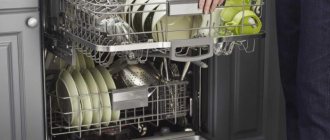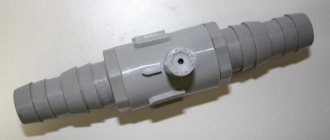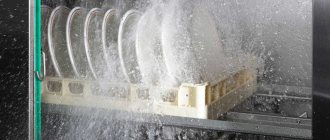Most of the automatic dishwashers currently offered in stores are models built into kitchen units with front-loading dishes. This technique simplifies the life of a housewife as much as possible.
I put dirty cutlery into the machine, pressed the button - and after a while the spoons, forks and plates were clean again.
In order for the dishwasher to work properly and wash dishes thoroughly, the machine requires water, regenerating salt and detergents. In this case, the water jets must have a set temperature, the salt composition must meet the requirements for NaCl purity, and liquids and washing tablets must be suitable for the specific model.
Each dishwasher unit is responsible for its part of the dishwashing process. If the heating element does not heat the water sufficiently, the pump does not pump it completely, and the ion exchanger or filters become clogged, then the dishes will remain dirty.
General operating principle of a dishwasher
The principle of its operation is quite simple.
To begin with, the device draws water, then, using a heating element, heats it to the required temperature. Heated water is mixed with detergent, and the resulting solution is fed into spray units located at the top and bottom of the machine chamber. Sprayers, rotating, spray jets of soap solution in different directions and with different pressures.
This allows all surfaces to be treated evenly, which significantly reduces the likelihood of streaks. Next, the soapy water enters the drainage pipe, and through it the water is discharged outside, but without any detergent residue. Thus, the machine cleans itself without requiring human intervention.
Preparing dishes and loading
There are rules that clearly stipulate how to load dishes and cutlery into the hopper of dishwashing equipment:
- Before loading dishes into the machine, you need to clear them of food residues:
- All items must be stable;
- Dirtier kitchen utensils are placed in the lower rack of the dishwasher;
- All containers are placed upside down so that water does not accumulate in them;
- Tall and narrow containers should not be installed in corners or in an overly inclined position;
- You can only load dishes into the machine once;
- The load should not exceed half the volume of the dishwasher;
- Do not load forks, spoons and knives into the machine;
- The following cannot be placed on the top plate of the machine: pots, frying pans without handles, cast iron frying pans;
- Close the car door tightly, so that there are no gaps.
Nothing should block the rotation of the rocker arms that spray water. Otherwise, the dishwashing efficiency will be reduced.
If necessary, you can place more dishes in the machine, but do not forget that their weight should be uniform. Proper loading of the dishwasher ensures high-quality and long-lasting dishwashing performance.
In addition, this saves time and detergents. On the other hand, if the dishes are loaded unevenly, they may not be washed properly due to uneven friction. This is especially true for pots and other items that have a smooth surface.
If you don't load your dishwasher correctly, you may end up with dried-on dirt and food residue on your dishes. If you have not prepared the dishes correctly, they will quickly become clogged with dirt and will not be washed properly.
Practical rules for operating the device that you will not find in the instructions
Using the device as written in the instructions is the key to quality work. However, it is not always possible (or desire) to read it. Therefore, we share important tips and nuances of operating the unit:
- The dishwasher is not intended for washing wooden products. Also be careful when washing ceramics, silver and brass. But glass and crystal can be loaded into the device without fear that they will break. A special program is provided for them.
- Place sharp objects in specially made compartments in the basket or in the top box. It is important that they do not interfere with the movement of the rocker arms.
- Lock the unit during operation to avoid the risk of burns.
- Do not open the door immediately after washing has finished. Let the dishes cool down a bit.
If you want to wash dishes with detergent that you use to wash dishes by hand, then remember that it should not foam much. Because it will damage the device. It is not recommended to immerse ordinary or laundry soap into the unit as a detergent. Under no circumstances should you set the drying mode if you put plastic dishes in the sink. As a result, it can either leak or become very soft.
If you see food residues on the bottom of the device after the device has finished operating, then you need to clean the drainage filter. To make it less clogged, you need to clear the dishes of food before loading.
Stages, washing cycles
Let's see what stages the dishes go through during the washing process.
In fact there are few of them:
- Pre-soaking. Jets of water knock off food residues from the dishes, preparing them for further processing;
- The washing up. The dishes are washed with jets of hot water with a special agent dissolved in it.
- Rinsing. Using hot water, remove any remaining detergent from the dishes. Depending on the control program algorithm or information received from sensors, the water may change several times during rinsing.
- Drying. Moisture is removed from the surface of the dishes. The result is completely washed and dried dishes, which all that remains is to put them in their usual place.
Water saving level in dishwashers
Both the selected washing mode and the PMM model determine how much water it will consume. On average, this is from 10 to 13 liters per procedure as a whole. Unlike manual washing, all water is used only for its intended purpose without any loss.
During the process, the working fluid is cleaned using special filters and is supplied completely renewed for rinsing. Economy modes reduce the amount of water consumed by 25%.
Water savings when using PMM are obvious. The unit uses a special technology in which the collected water is used several times
The profitability of PMM is indicated by symbols. Highly economical units are marked with the letters A, B, C. They consume 9 - 16 liters. Average-economical dishwashers are designated in the form of the letters D, E. They consume slightly more water - up to 20 liters. Low-efficiency machines with the letters F, G require 26 liters per cycle.
Extra rinse mode
The rinse mode in the dishwasher is provided in each of the programs used. Some use heated water, others use cold water.
However, sometimes the standard rinsing mode is not enough. In wash cycles, this function is provided to rinse away detergent and make dishes shine. But if the containers are heavily soiled, food particles may remain on them even after several rinses.
If you only wash dishes once in the evening, they may sit in the dishwasher for several hours. During this time, leftover food on plates, pans and pots will dry out. During washing, they will be very difficult to remove, and particles of dirt may remain on the dishes.
To prevent this from happening, use the pre-rinse mode. It is recommended to turn it on before using the main cycle or even 2-3 times during the day so that food residues do not dry out on the dishes until you fully load the dishwasher. When you turn on the rinse cycle in your dishwasher, no detergent is used.
Control method
Modern models of dishwashers are electronically controlled. But among the wide range you can also find mechanical elements. The most convenient to use options are those with a display and touch keys. However, their disadvantage is that they only respond to the warm touch of the fingers. But this minus is practically not taken into account when purchasing.
PHOTO: naahq.org Touch control dishwasher with backlit buttons
As for the mechanical buttons, which must be pressed forcefully to start the mode, they are short-lived, since their mechanism often breaks down. Also, due to moisture and dust, such keys may no longer function properly.
Related article:
Drying class
Modern dishwashers, in addition to the “energy consumption class” and “washing class,” have a parameter called “drying class.” It is determined by conducting test measurements. Depending on how much water is left on the dishes, the machine is assigned a class A, B or C.
Drying class A or B is a completely acceptable option. Class A means that the manufacturer promises us perfectly dry dishes. Classes B and C allow the presence of some moisture (drops) on the dishes.
Connection
To choose the right dishwasher, you need to immediately think about how you will connect it. But before that, think about what dimensions suit you, because there are more compact options. There are several methods for connecting to the highway:
Cold water supply. The PMM will independently heat the water to the required temperature, but then the electricity consumption increases.
Cold and hot water supply immediately. This method is considered more economical, since you can save on water heating
But here it is important to take into account the quality of hot water in your city.
Modes and additional functions of the dishwasher
Operating a dishwasher will not be particularly difficult; the basic principles and rules of use, as well as the dishwasher modes, will make the work of any housewife easier.
The dishwasher has two main operating modes:
- fast;
- intensive.
The fast mode provides the most gentle washing of dishes, which does not require additional rinsing or drying.
The intensive washing mode is designed for a more thorough, thorough washing of soiled dishes.
In models that have a delay start timer, after setting it, you can set the dishwasher to run at a certain time so that it washes the dishes at the right time.
There are also additional functions, such as: self-cleaning and leakage protection.
Self-cleaning is an additional feature that will allow you to save water and energy, and also significantly reduce salt consumption. This function is very convenient if you use a dishwasher at home and do not want to change the salt often.
The Leak Protection feature is also an optional feature. When it is turned on, water in the event of a leak will not flow to your appliances. This will prevent serious damage in the event of flooding.
Basic elements
All dishwashing devices have the same parts, which are interchangeable on many models.
To see them, you need to remove the case by unscrewing a few screws. The interior consists of the following parts:
- Circulation pump. It is combined with the PMM engine and serves to pump and supply fluid to the rocker arm sprayers.
- Drainage pump (DP). It is necessary to drain water at the end of the process.
- Water pump. It is attached to the engine housing and serves to remove liquid, pieces of food and fat from the filter.
- The heater is flow-through. Provides heating of the liquid to the temperature specified by the program. Installed inside the main LP pump.
- PMM control board. This is the main “brain” that supports the operation of all components of the device.
- Filler hose. Serves for intake (receipt) of working fluid into the unit tank. It is equipped with a leakage protection unit.
- Drain hose. It has several pipes for draining water from the inside of the unit and discharging contaminated liquid into the sewerage system.
- Pressostat. This sensor is designed to measure the water level in the PMM and the pressure in the tubes.
- Ion exchanger. This is a reservoir with a special resin necessary to soften the working fluid.
- Cleaning filter. It is installed at the inlet hose (inlet) of the “dishwasher” and protects the device from rust, sand and other fine elements from the water supply entering its system. It is designed to retain any type of contaminant, since perfectly clean water must flow into the engine.
- Hoses and clamps. Ensure unhindered passage of the working environment between nodes.
- Electrical wiring is necessary for the operation of the device.
- Noise insulation - muffles the sounds of running motors and pumps.
- Water collector.
When examining the PMM from the side of the tank, the following elements become visible:
- Sprinklers (in everyday life - rocker arms) are lower and upper, through which water is thrown into the machine. They rotate during the washing process and spray water onto the dishes.
- Baskets (stainless steel mesh) for storing dishes and cutlery.
- Double filter unit. It consists of two containers with a very fine mesh, one of which is installed at the bottom of the PMM. The second filter is located on top of the first.
- Salt compartment.
- Containers intended for detergents (located on the door).
- Rubber sealing the tank.
PMM washing completion time
When the dishwasher completes the wash cycle, the appliance beeps and shuts down.
The control panel contains convenient indicators for the end of the program; using the settings, you can change the volume of the sound signal or turn off the end-of-work notification.
This is especially true when loading dishes overnight.
After the machine has stopped completely, press the power on/off button.
It is recommended to wait about 15 minutes before removing dishes as they may be very hot after drying and some items may become fragile.
Selecting work programs
The best washing effect is provided by the ECO (economical) program, but if the dishes are heavily soiled, you should still choose “intensive washing”.
For washing fragile dishes, a delicate mode is used, which differs from all others in that the water temperature will rise during the first rinse. By the way, this same mode is also suitable if the dishwasher contains dishes of completely different types and materials.
Important! It is impossible to tear off the machine immediately after the last cycle is completed. It is recommended to wait about 25 minutes more to allow the dishes to cool down.
Finally, it should be noted that you need to wash the machine, or rather its filters, after each start; to do this, it will be enough to wipe them with a damp washcloth. We should not forget about the sprinkler nozzles; it is very important to ensure that they are not clogged.
Beam on the floor
Most commercially available dishwashers are built-in. They are installed in a kitchen unit, and the front panel of the device is covered with a furniture facade.
The controls are located on the top edge of the door, so they are not visible unless you open it. Manufacturers try to ensure that the equipment works as quietly as possible, so it is not always possible to immediately determine whether the washing cycle has ended or not.
To prevent users from having to listen or open the door, some dishwasher models are equipped with a Floor Beam function.
The “floor beam” in your dishwasher is a light projection that helps you monitor the progress of the dishwasher. It can work in several ways.
Sometimes a light point near the dishwasher door appears only after the program ends. In other models, on the contrary, it goes out after the device finishes working. There is another option - changing the color of the beam from red to green. And the most difficult thing is to project onto the floor not just a point of light, but the time remaining until the end of the program.
The “Beam on the floor” function allows you to do without a sound signal when the dishwasher finishes working. This option will be appreciated by families with small children, as well as those who usually turn on the device at night.
Types of modern models
Not all apartments have spacious kitchens that can accommodate full-size dishwashers. Therefore, manufacturers have invented many alternative devices that can wash dishes and not take up much space. All of them are exclusively electric with forced water pressure.
Four structural types of PMM can be distinguished:
- Built-in under the countertop.
- Standing separately.
- Compact and portable.
- Top loading.
PMMs built under the countertop usually have a depth of 57 cm, which allows for the necessary communications between the device and the wall. But different models can differ significantly in their characteristics from each other, which is worth considering when choosing a suitable dishwasher. We reviewed the main selection criteria and rating of the best built-in models in this publication.
If installed correctly, the front edge of the built-in machine with a depth of 57 cm will be flush with the table. We wrote more about installing a built-in dishwasher here.
In terms of width, dishwashers can be compact (44-46 cm) or full-size (56-60 cm). Their height is usually standard - 81-82 cm with the ability to adjust.
Image gallery
Photo from
Built-in under-table dishwasher
Freestanding dishwasher
Portable dishwasher
PMM with vertical loading of dishes
Freestanding PMMs are equipped with a beautiful and durable top panel on which you can put some things. The vibration of the machine during operation is minimal, so you don’t have to worry about objects slipping. We talked in more detail about the characteristics of free-standing machines and the features of choosing the best one in the next article.
Such devices are installed either near the edge of the tabletop, or in the next room where there are the necessary communications. The dimensions of free-standing PMMs are similar to built-in ones.
Compact, portable dishwashers are convenient when living in rented apartments. They do not require installation work and can be installed both on the floor and on a table. The typical size of such a PMM is 44*55*50 cm, which should be taken into account when choosing.
To connect them, just connect a flexible hose to the water tap and lower the drain pipe of the machine into the sink.
PMMs with vertical loading are rarely produced. They usually have one level of storage of dishes, therefore they are functionally limited.
Regardless of the type of dishwasher, their operating principle is similar. However, the technical features of the models still affect the quality of cleaning dishes and the energy efficiency of the devices as a whole.
Prevention and cleaning of PMM
To avoid any questions about how to clean a dishwasher, you should, whenever possible, “clean” the inside of the appliance after each use.
Simple tips:
- If you use the device daily, and not on holidays, you can avoid drying of fat and food residues.
- Before washing dishes in the dishwasher, they should be rinsed with hot running water to remove any remaining food and some grease.
- Be sure to wipe the door and gaskets with a damp cloth and detergent after each use. If dirt gets into them, an unpleasant rotten smell may develop over time.
- Clean the device periodically with vinegar. To do this, pour two glasses of liquid into the bottom of the dishwasher and turn on a quick wash without dishes.
- To combat the smell, you can fill the bottom of the device with a glass of baking soda and use the machine as usual.
- After each use, leave the machine door open to allow the inside to dry.
PMM service
First of all, the surfaces of the washing chamber require care. They are made of stainless steel, which imposes certain restrictions on the cleaning products used.
Do not use products containing chlorine or abrasives. They can ruin the surface, leave permanent stains and deep scratches.
As a rule, surfaces are wiped with a soft cloth slightly moistened with a detergent solution. In most cases, manual cleaning of the washing chamber is absolutely unnecessary. It's all about the dishwashing detergents used. If high-quality products are used and the regenerating salt and rinse aid dispensers are set up correctly, the internal surfaces will be cleaned along with the dishes.
The operating instructions describe how to correctly set the salt and rinse aid consumption. It is important to understand here that the hardness of tap water and other parameters vary depending on the region, so the dosage is often selected experimentally: after completing the washing cycle, the condition of the internal surfaces is assessed, and, if necessary, the level of salt and rinse aid consumption is adjusted.
With the correct settings, the internal surfaces of the dishwasher are free of limescale, streaks and other contaminants. They remain perfectly dry and clean.
In particularly “neglected” cases, wipe the walls of the chamber with a soft cloth soaked in table vinegar. Or, place a container (100-150 ml) with vinegar in one of the baskets of an empty dishwasher and start the washing cycle, after which the walls of the chamber are washed with dishwashing detergent.
The rubber seals on the car door deserve special attention. Limescale deposits accumulate on them, interfering with a normal fit.
Such contaminants are removed with a sponge or rag soaked in table vinegar.
To prevent corrosion on dishwasher baskets made of enameled metal rods and other elements of the dishwasher, it is recommended to wipe them dry after each use.
To prevent condensation from forming inside the compartment, leave the door open until the dishwasher has completely cooled down.
If you are using a non-built-in (free-standing, tabletop) dishwasher model, the user’s attention will also be required on its outer surfaces. They are cleaned with a slightly damp sponge or cloth soaked in a cleaning solution.
Like any other equipment, a dishwasher needs proper and regular care. Maintenance and care procedures are simple and will not take much time, but if you ignore them, the dishwasher will turn into a piece of furniture and will no longer be able to perform its direct functions.











